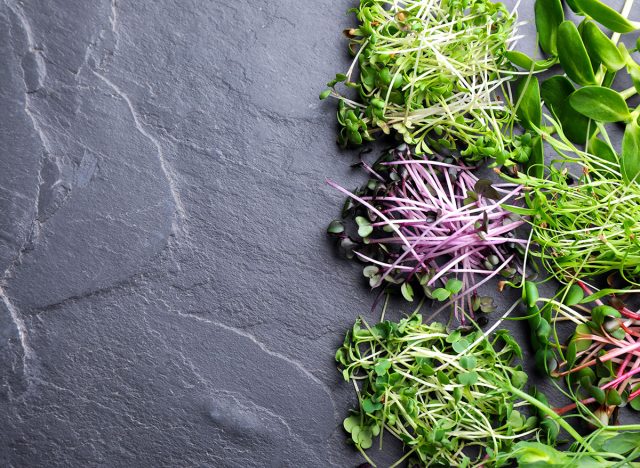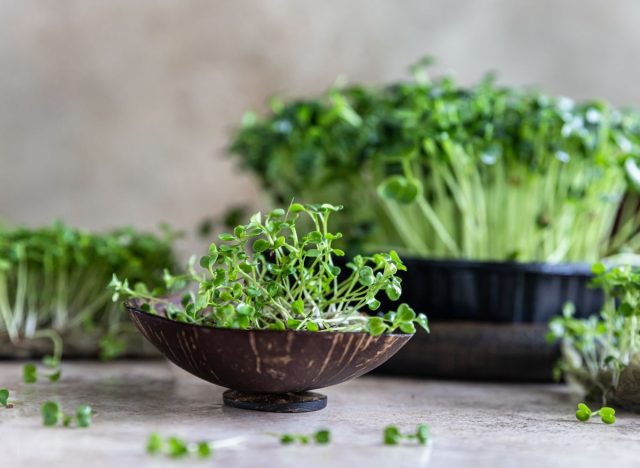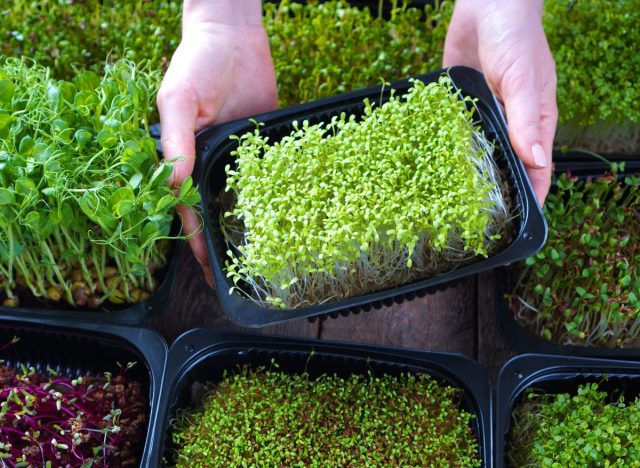Surprising Effects of Eating Microgreens

Microgreens have been around for quite some time, but they’ve just recently started gaining more popularity as flavor-filled salad toppers or a yummy addition to your favorite avocado toast. And although many people mistake microgreens for sprouts, they’re actually not the same at all.
According to Healthline, microgreens are more developed than sprouts but not quite a baby green. These greens are harvested as soon as they start to grow their leaves, which is usually anywhere from seven to 21 days after the seeds are germinated.
Many different types of seeds can yield microgreens, with some of the most popular ones being from the seeds of radishes, broccoli, arugula, and even sunflowers.
These tiny greens not only pack a punch of flavor, but they come with a ton of health benefits, too. While the specific benefits often vary based on the type of seed the microgreen originates from, a recent report from the Journal of Future Foods found that microgreens can have anti-inflammatory, anti-cancer, and anti-bacterial properties to them.
More research is being done on microgreen nutrition as it continues to grow in popularity, but read on to learn what dietitians and researchers have to say about this nutrient-dense food. Then for more healthy eating tips, check out Major Effects Bananas Have on Your Health.
They contain plenty of plant compounds.

According to Amy Goodson, MS, RD, CSSD, LD author of The Sports Nutrition Playbook and member of our Medical Expert Board, a major benefit of eating more microgreens is their high levels of antioxidants.
“Microgreens contain antioxidants, which help fight disease and sickness by protecting your cells,” says Goodson, “and research suggests that they actually have more of the antioxidant polyphenols than most mature greens.”
This often depends on the type of seed, too. According to Frontiers in Nutrition, broccoli microgreens have higher levels of many antioxidants and minerals than their adult counterparts.
Some types may be a good source of potassium.

Goodson adds that many types of microgreens come loaded with potassium, which can help meet your recommended daily amounts.
“One cup of microgreens provides 10-11% of your dietary potassium needs, making them an official ‘good source’ of potassium,” says Goodson. “In fact, most Americans don’t get enough potassium at all, so adding a cup of microgreens to a salad or omelet can be a great way to boost your intake.”
Microgreens contain prebiotics.

All vegetables contain certain levels of prebiotics, which are types of fibers that are essential for your gut health. According to Morgyn Clair, MS, RDN, author at Fit Healthy Momma, this is another great reason to add microgreens to your diet.
“There are high levels of prebiotics in many types of microgreens, which help promote the growth of healthy bacteria in the gut,” says Clair, “and the best way to ensure high levels of these nutrients is to eat them raw as a meal topper or salad additive.”
The also contain high levels of helpful plant pigments.

Many plants contain natural pigments that not only give them their fun, vibrant colors, but also provide a handful of health benefits. For example, carotenoids are what give veggies like carrots or bell peppers their orange and red coloring, and have been known to aid in eye health, cardiovascular health, and even helping to reduce the risk of certain cancers.
According to a report in Foods, microgreens contain high levels of pigments like carotenoids, as well as other common plant pigments like chlorophyll and anthocyanin, all of which contain helpful benefits.
They may contain trace metals.

While microgreens are mainly beneficial to our overall health, there is one thing that researchers want us to be aware of. According to the Foods report, some microgreens have been found to have trace metals and potentially high amounts of nitrate in them.
The report states that the reasoning behind this has to do with the growing sites of many microgreens, like weeded farmlands, the bordered areas of roads or paths, and other areas with heavier human traffic, which often contain soil that is higher in nitrates.
This doesn’t mean you should avoid microgreens altogether, but it’s a necessary risk to be aware of.









